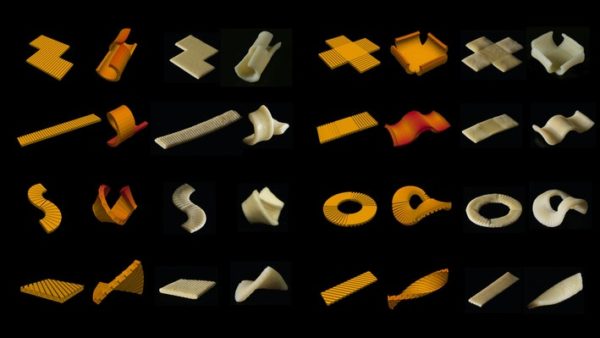What do pasta and IKEA have in common?
Until recently, not much… but there’s an interesting trait they may soon share: “Assembly Required!”
That’s right – food is meeting construction as scientists have revealed a way to assemble a delicious “flat-packed” Italian dish that’s easy to transport. Plus, it’s environmentally friendly. Mangia!
It’s a piece of pasta

Image source: Morphing Matter Lab. Carnegie Mellon University
Carnegie Mellon University’s Morphing Matter Lab director Lining Yao says, “Based on our geometrical calculation, flatly packed macaroni pasta could save more than 60% of the packaging space. Because more than half of the food packaging space, in this case, is used to pack air.”
In a recent study, Yao and her colleagues figured out how flat-packed pasta can be twisted into all sorts of shapes in just seconds. The secret is in the impressed grooves on the pieces of pasta themselves.
Using this kind of unique design would help streamline the manufacturing process while reducing wasted food and space.
It’s not an impasta!
This isn’t the researchers’ first attempt at designing a flatter pasta.
Previously, their prototypes had fallen short… but now they’re using a mix of physical experiments and simulations to recreate and predict the morphing of pasta shapes. This has been a game-changer!
By using different patterns of stamped shapes into the noodles – and determining why it worked the way it did – scientists were able to create a variety of 3D pasta shapes that take their proper shape when placed in water.
Since we already can buy flat pasta shapes like fettuccine, this would help other shapes like spirals or macaroni. It would also greatly reduce the amount of plastic used and shipped around the world.
These pasta shapes cook at the same time as regular pasta (about 7-12 minutes). And after the flour-based 3D pasta meets water, the shape becomes irreversible… which is probably preferable for those who want an authentic bite of their meal.
The future of food
According to the EPA, the single-use plastic often used in food packaging is a huge contributor to landfills. This new method of transporting the flat pasta in tight packages would reduce plastic use, cost, and emissions during transportation.
The researchers are still figuring out ways for even more complicated 3D shapes and are looking to apply the process to different foods.
“We have only quantitatively tested pasta so far,” says Yao. “However, in principle, we anticipate this can be adapted to a variety of food that can swell in water, including food gels – like gelatin dessert, or Japanese wagashi – and other flour-based noodles.”
What do you think about this innovation in the food industry? Will more people be willing to try this type of “assembled” food?
Let us know what you think down in the box below!
Header image source: Morphing Matter Lab. Carnegie Mellon University
Love the idea! 🙂🙂🙂
Anything that contributes to the lowering of plastics, especially single use plastics is worth consideration. If the food end product is fine I would say go for it.
Sounds great to me! Anything that reduces waste makes me happy!
I think it’s a far fetched idea. If you know anything about pasta, there are two secrets: ingredients(durum), cutting(bronze) and drying. So this hybrid does not solve any quality issues. Is it a frozen food idea, in which case it could be already cooked or half cooked? I don’t quite get it. At list not for Italian pasta which, by the way, is supposed to be “al dente” ( hard to the bite) to be real.
Sounds like a win-win!
Sounds good to me.
Love the creative thinking that has the potential to decrease our negative footprint on our world, and inspire others to follow this type of view of our planet.
I’d try it. Sounds interesting.